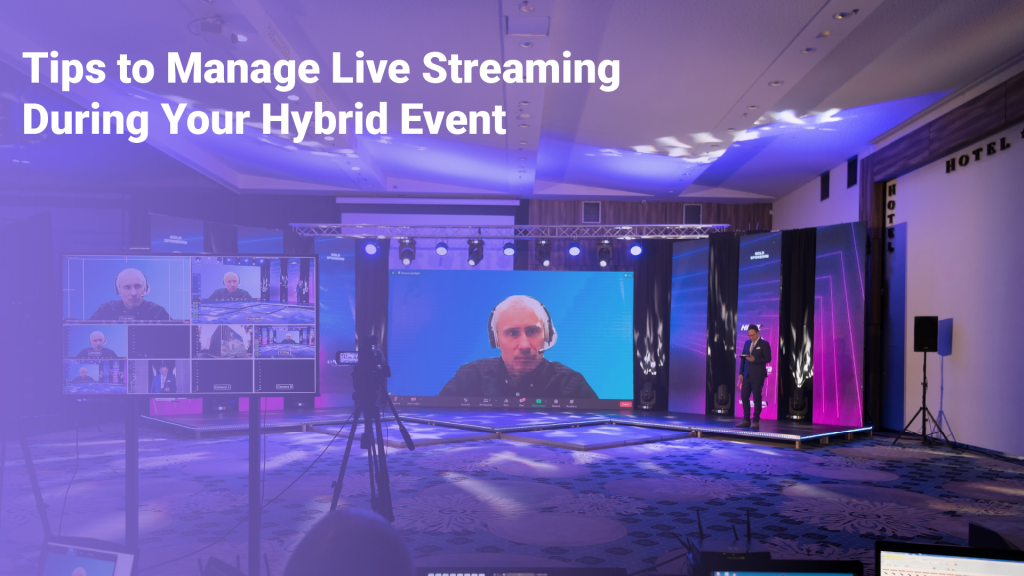
Hybrid event management: Discover essential tips for managing live streaming during your hybrid event successfully.
The rise of hybrid events has transformed the way we connect and engage with audiences. By combining in-person and virtual elements, hybrid events offer a unique opportunity to reach a wider audience and provide an immersive experience.
However, managing live streaming during a hybrid event can present its own set of challenges. From technical considerations to audience engagement, there are several factors to consider to ensure a seamless and successful live-streaming experience. In this article, we will explore some essential tips to help you effectively manage live streaming during your hybrid event.
How You Can Better Manage Live Streaming During Your Hybrid Event?
Plan Your Live Streaming Strategy
Before diving into the technical aspects of live streaming, it is crucial to develop a comprehensive strategy for your hybrid event. Start by clearly defining your objectives and understanding your target audience.
Determine the key sessions or moments that should be live-streamed to provide maximum value to virtual attendees. Create a content calendar and allocate resources accordingly.
Invest in Quality Equipment, Reliable Internet and Best Virtual Conference Platform
Choosing the right and Best Virtual Conference Platforms is also very important. To ensure a smooth live streaming experience, invest in quality equipment and a reliable internet connection. Consider using professional cameras, microphones, and lighting equipment to enhance your live stream’s visual and audio quality.
Test your setup beforehand to identify and resolve any technical issues. Opt for a stable internet connection with sufficient bandwidth to accommodate the streaming requirements. Redundancy is crucial, so have backup equipment and an alternative internet connection available in case of any unexpected disruptions.
Engage Virtual Attendees
While your in-person audience is physically present, it’s essential to engage virtual attendees actively. Incorporate interactive elements into your live stream, such as live chat, Q&A sessions, and polls.
Encourage virtual participants to ask questions and provide real-time responses. Assign a dedicated moderator to monitor and manage the virtual engagement, ensuring that all questions are addressed promptly.
Provide Clear Instructions for Virtual Attendees
Make sure virtual attendees understand how to access and navigate the live stream. Provide clear instructions on how to join the virtual event, access session recordings, and engage with other participants. Share relevant links, passwords, and technical requirements in advance.
Consider conducting a pre-event orientation or rehearsal session for virtual attendees to familiarize themselves with the platform and address any concerns or queries.
Monitor and Manage the Live Stream
During the hybrid event, it is crucial to monitor and manage the live stream actively. Assign a dedicated team member to oversee the streaming process and address any technical issues that may arise.
Ensure that the audio and video quality remains consistent throughout the event. Monitor the chat and social media platforms for any feedback or questions from virtual participants. Maintain a prompt and professional response to keep virtual attendees engaged and connected.
Leverage Analytics and Feedback
After the event, leverage analytics and feedback to assess the success of your live-streaming efforts. Analyze viewership statistics, engagement metrics, and audience feedback to identify areas of improvement.
Use this data to refine your live-streaming strategy for future hybrid events. Consider conducting post-event surveys to gather feedback from both in-person and virtual attendees, helping you gain valuable insights and understand their experience.
Ensure Data Privacy and Security
In the digital age, data privacy, and security are paramount concerns. When managing live streaming during your hybrid event, take necessary precautions to protect virtual attendees’ personal information and data. Use secure streaming platforms and ensure that any sensitive information shared during the event is handled securely.
Communicate your data privacy policy clearly to attendees and obtain their consent for data collection and usage. Regularly update your security protocols to stay ahead of potential threats and vulnerabilities.
Test and Rehearse Beforehand
To mitigate any technical glitches or unforeseen issues, conduct thorough testing and rehearsals before the hybrid event. Test the live streaming setup, audiovisual equipment, and internet connection to ensure everything functions smoothly.
Conduct a full-scale run-through of the event, simulating the in-person and virtual components, to identify any potential hiccups and address them proactively. Rehearsing the event will help you streamline transitions, manage timing effectively, and troubleshoot any challenges that may arise.
Offer On-Demand Access
While live streaming provides real-time engagement, it’s also important to offer on-demand access to the recorded sessions. Virtual attendees may have different time zones or scheduling conflicts, and providing access to recorded content allows them to catch up at their convenience.
Ensure the recorded sessions are easily accessible through a designated platform or website. Consider organizing the content into a library or playlist, categorizing sessions for easy navigation. This flexibility will enhance the overall virtual attendee experience and extend the reach and impact of your hybrid event.
Foster Networking Opportunities
One of the advantages of attending events, whether in person or virtually, is the opportunity to network and connect with like-minded professionals. To ensure virtual attendees feel included, provide networking opportunities specifically designed for them.
Incorporate virtual networking sessions, breakout rooms, or dedicated virtual lounges where attendees can discuss, exchange contact information, and build connections.
Utilize online collaboration tools or event platforms that offer virtual networking features to facilitate meaningful interactions. Encourage virtual attendees to actively participate in networking activities to maximize their engagement and overall satisfaction with the event.
Conclusion
Managing live streaming during a hybrid event requires careful planning, technical expertise, a focus on audience engagement, data privacy, and security measures, as well as thorough testing and rehearsals. It is very important to choose the Best Virtual Event Platform because the success of your event mostly depends upon the platform. We suggest you choose HuddleXR. It is an amazing platform that helps you with virtual and hybrid events.
By implementing the tips mentioned above, such as planning your strategy, investing in quality equipment, engaging virtual attendees, providing clear instructions, monitoring the live stream, leveraging analytics, prioritizing data privacy and security, conducting thorough testing and rehearsals, offering on-demand access, and fostering networking opportunities, you can ensure a seamless and enjoyable experience for both in-person and virtual attendees.
With effective management of live streaming, your hybrid event can reach new heights of success, leaving a lasting impact on your audience, whether they participate in person or virtually.






